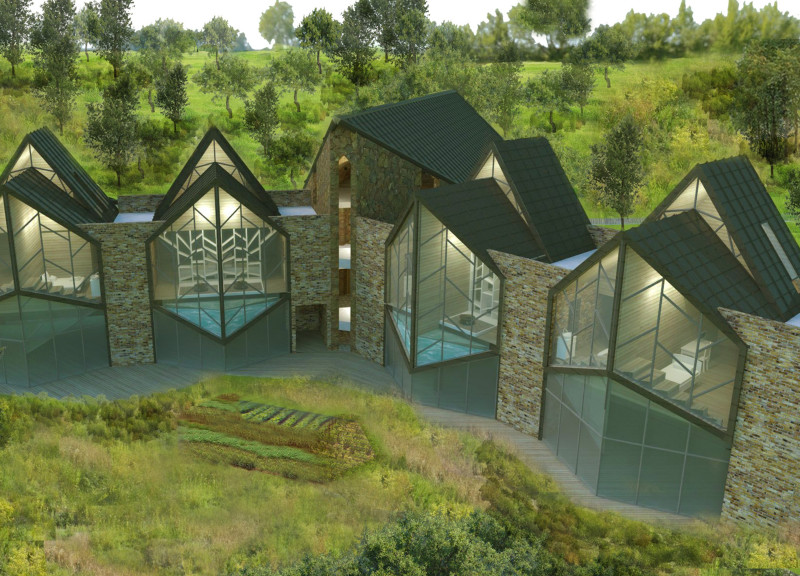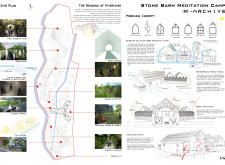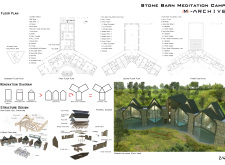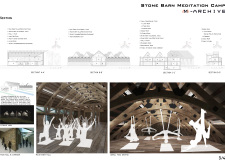5 key facts about this project
Functionally, the Stone Barn Meditation Camp is divided into several key areas that cater to diverse activities and user experiences. A fruit garden and farm occupy a central role within the project, emphasizing sustainability and providing fresh produce that contributes to the camp's self-sufficiency. This section not only serves a practical purpose but also encourages participants to engage with the process of growth, fostering a deeper understanding of food sources and ecological balance. Complementing this is a greenhouse designed to enhance the educational experience, offering opportunities for learning about plant care, agriculture, and the environment.
The design also features a sauna and water pump area, enhancing the overall wellness experience for visitors. This facility underscores the importance of relaxation and rejuvenation in the camp’s offerings, providing spaces for users to unwind in a natural setting. Additionally, creatively designed covered terraces and playgrounds cater to various group dynamics, supporting both communal relaxation and playful interaction. The intentional planning of these spaces reflects an understanding of the generational needs, accommodating families, solo visitors, and groups seeking collaborative experiences.
A critical aspect of the architectural design is the integration of meditation zones strategically placed throughout the site. These areas offer solitude for individual reflection while simultaneously allowing for group activities when needed. The layout of these spaces demonstrates an acute awareness of privacy and tranquility, which are vital for effective meditation practices.
Materiality plays a significant role in the overall architectural vision of the camp. A thoughtful selection of materials, including wood, glass, and stone, not only enhances aesthetic appeal but also ensures that the buildings resonate with the natural landscape surrounding them. Wood is utilized extensively, providing a warm, inviting atmosphere that harmonizes with the natural environment. Glass elements create transparency, allowing abundant natural light to penetrate interior spaces and blurring the lines between outside and inside. The use of stone conveys a sense of permanence and connection to the earth, reinforcing the intention of grounding participants in the landscape.
Beyond aesthetics, the Stone Barn Meditation Camp incorporates various innovative strategies to promote sustainability. Features such as rainwater harvesting systems exemplify the project’s commitment to environmental responsibility, significantly reducing dependency on external water sources. Solar panels integrated into the design reflect a forward-thinking approach to energy management, aligning with contemporary practices that prioritize renewable resources. Additionally, the thoughtful utilization of natural ventilation minimizes energy consumption for heating and cooling, showcasing an integrated approach to environmental design.
One of the unique design approaches in this project is the way it simultaneously addresses communal and solitary experiences. The careful zoning of spaces ensures that while individuals can find their quiet moments for reflection, they can also easily engage with a community of like-minded individuals. This duality is critical in retreat environments where the objectives often hinge on both personal growth and collaborative interaction. The architectural configurations encourage fluid movement through various areas, enhancing the overall experience without compromising the privacy needed for meditation.
In summary, the Stone Barn Meditation Camp serves as a model for how architecture can be employed thoughtfully to encourage mindfulness and connection to nature. The project’s distinctive features, from its careful material selection to its innovative sustainability practices, encapsulate a vision focused on holistic wellness. For those interested in understanding the intricate details of this project, exploring the architectural plans, sections, designs, and ideas will provide deeper insights into its thoughtful conception and execution. Engaging with these elements can enhance one's appreciation of how architecture can facilitate meaningful experiences in a natural setting.


























